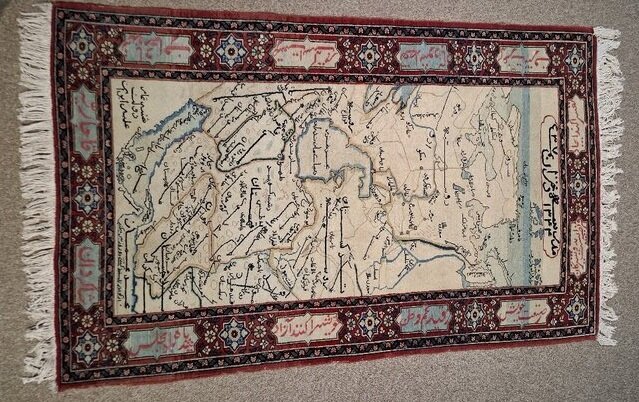Rarely-seen Qajar-era carpet unveiled for Tehran Week

TEHRAN – A rare historical carpet woven by Qajar-era schoolgirls was unveiled at the Carpet Museum of Iran in central Tehran this week, as part of celebrations marking Tehran Week, which runs from October 3 to 9.
The carpet, woven in 1344 AH (1925 CE) by young female artists at a girls’ school during the late Qajar dynasty, was presented to the public in a ceremony attended by cultural officials and museum representatives.
“This carpet is not only a unique artwork, but also a historical document reflecting Tehran’s cultural identity,” said Mohammad Javad Inanluo, the museum director.
Inanlou said the border inscription on the carpet reflects the beliefs and historical awareness of its young weavers. The design features motifs representing Iran, Tehran, and the Persian Gulf, woven in vibrant patterns.
“The name ‘Tehran’ stands out as the capital of Iran in the design, and ‘Persian Gulf’ is prominently displayed in the text,” Inanlou added. “Through this piece, the artists expressed their love for their homeland and cultural roots in a visual, poetic form.”
Located northwest of Laleh Park, the Carpet Museum of Iran houses about 2,000 carpets and floor coverings, including pieces from the Safavid era and beyond. The museum, spanning 3,400 square meters, also showcases rare rugs, kilims, and tableau rugs from across the country.
Inanlou emphasized the educational and cultural role of museums in preserving heritage. “Museums are not just storage places for objects—they are living universities where history, art, and culture can be experienced,” he said.
He also called on citizens, researchers, and visitors to view the newly unveiled carpet. “This exhibition is an opportunity to understand the deep connection between art and history,” he said. “Tehran Week is the perfect time to reflect on the city’s cultural heritage.”
The carpet will remain on display at the Carpet Museum during Tehran Week.
Glimpses of Persian carpet
Persian carpets are sought after internationally, with patterns of Persian garden being arguably the most characteristic feature of them all. Weavers spend several months in front of a loom, stringing and knotting thousands of threads. Some practice established patterns. Some make their own.
Each Persian carpet is a scene that seems ageless, a procedure that can take as long as a year. These efforts have long put Iran’s carpets among the most complex and labor-intensive handicrafts in the world. When the weaving is finally done, the carpet is cut, washed, and put out in the sun to dry.
Throughout history, invaders, politicians, and even enemies have left their impact on Iran’s carpets. As mentioned by the Britannica Encyclopedia, little is known about Persian carpet-making before the 15th century, when art was already approaching a peak.
AM
Leave a Comment